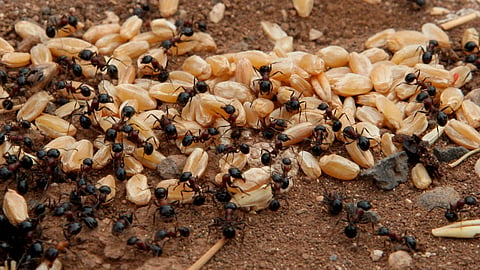

Orli Snir, a biologist at the Rockefeller University in New York, couldn’t keep her ants alive. She had plucked pupae from a colony of clonal raider ants, where the sesame seed-size offspring that looked like puffed rice cereal were being fussed over by both younger larvae and older adult ants. Then she had isolated each pupa into a tiny, dry test tube. And every time, they drowned.
More specifically, each pupa was leaking so much watery, golden-tinted fluid it was struggling to breathe. But they lived when Dr. Snir whisked the fluid away with a capillary tube. Her humble observation led down a strange path of experiments toward a bizarre but inescapable conclusion: This mysterious ant goo functions a lot like milk.
Not just one ant species uses this milk, either. Perhaps all ants do, according to a paper led by Dr. Snir that was published Wednesday in the journal Nature. It adds ants among other unexpected creatures like pigeons, spiders and beetles that feed each other milk-like fluids. And much like milk in mammals, it knits together ants of different generations — and the larger ant society, too.
After first noticing the strange secretions, Dr. Snir scanned through the scientific literature and it seemed that her ant pupae were oozing something that was mostly unknown to science. She shared what she had found with her co-author, Daniel Kronauer, who leads a research group on ant evolution at Rockefeller. “My first thought was, ‘This is crazy,’” he said.
In the traditional view, ant pupae are passive, trapped in a dull, transitional phase of life. The insect starts as a wriggling, wormlike larva, then seals itself into an inert pupa that looks like a living sleeping bag, emerging as a full-grown adult. Inside a living colony, where these three phases are in a hubbub of constant, inscrutable contact, pupae seem to stay dry.
So where does this pupae juice normally go? To find out, Dr. Snir added blue food colouring to pupae shells. Then she put them back into an ant colony, where pupae are stored in a slimy heap oddly reminiscent of risotto. Within hours, she found, adult ants and larvae took on a blue tint, a sign that both groups siphon away the fluid. Adult ants even seem to pick up larvae and put them on top of pupae so that the colony’s youngest members can slurp up the secretions.
The team’s further experiments uncovered a web of codependent relationships. If adult ants don’t lick off the pupal fluid, the pupae drown or die of fungal infections. And if newly hatched larvae don’t get to drink it, they’re less likely to survive. As for what the adults get for consuming the stuff themselves, that’s still unclear, but early studies show it contains hormones and neuroactive compounds.
Then the team looked at pupae from four other ant species from across the ant tree of life. Each of these species seemed to have a similar fluid, suggesting the newly recognized “milk” is common among ants.
“I am absolutely excited about this work, which I consider very important,” said Bert Hölldobler, an ant biologist at Arizona State University who didn’t participate in the research. In 1977, Dr. Hölldobler added, he published an observation that adult ants gravitated to chemical compounds on the skin of pupae, but he hadn’t taken the topic any further.
Visit news.dtnext.in to explore our interactive epaper!
Download the DT Next app for more exciting features!
Click here for iOS
Click here for Android